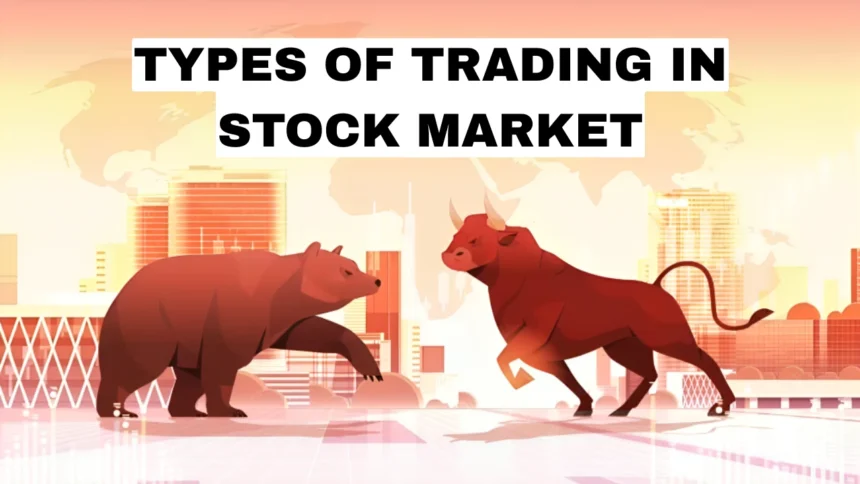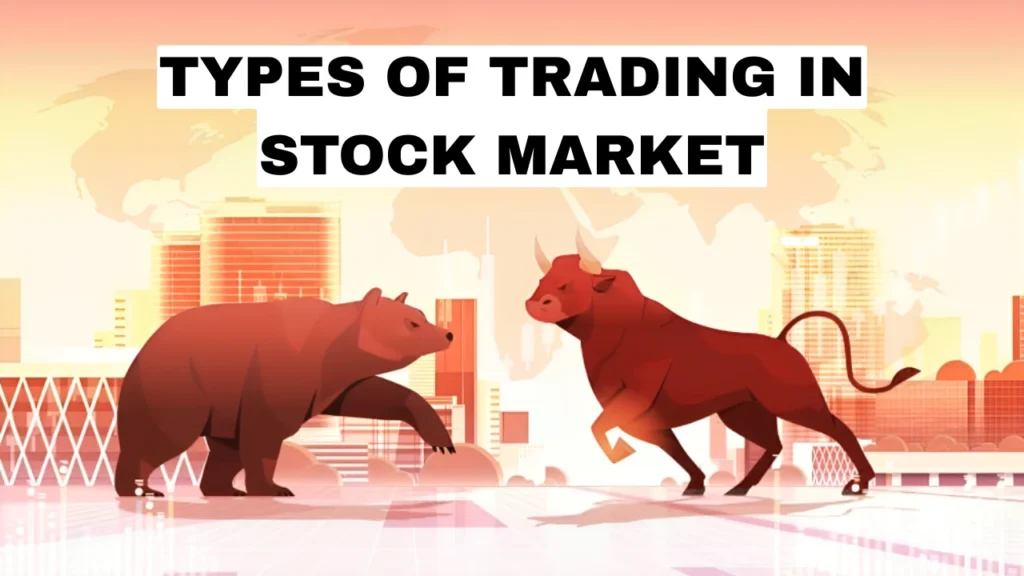The world of trading opens countless pathways to financial growth, yet choosing the right approach can feel overwhelming. Whether you’re dreaming of quick profits or building long-term wealth, understanding the types of trading in stock market is your first crucial step toward achieving financial independence. Every successful trader started exactly where you are now—seeking knowledge and clarity about which trading strategy aligns with their goals, risk tolerance, and lifestyle.
- Understanding Stock Market Trading Fundamentals
- Essential Trading Components
- Intraday Trading – The Art of Same-Day Profits
- Intraday Trading Characteristics
- Intraday Trading Strategies
- Scalping – Mastering Micro-Movements
- Scalping Requirements and Challenges
- Scalping vs Other Trading Styles
- Types of Trading in Stock Market: Swing Trading – Capturing Market Swings
- Swing Trading Methodology
- Swing Trading Advantages and Considerations
- Position Trading – Long-Term Trend Following
- Position Trading Characteristics
- Position Trading Benefits and Challenges
- Momentum Trading – Riding Market Trends
- Momentum Trading Strategies
- Momentum Trading Implementation
- Technical Trading vs Fundamental Trading
- Technical Analysis Components
- Fundamental Analysis Approach
- Options and Futures Trading
- Options Trading Fundamentals
- Futures Trading Characteristics
- Algorithmic and High-Frequency Trading
- Algorithmic Trading Development
- High-Frequency Trading Characteristics
- Specialized Trading Strategies
- News Trading Strategy
- Breakout Trading Implementation
- FAQ
- Disclaimer
Understanding Stock Market Trading Fundamentals
Trading represents the buying and selling of financial instruments with the primary goal of generating profits from price movements. Unlike long-term investing, trading focuses on capitalizing on short-term market fluctuations through various strategic approaches. The foundation of successful trading lies in understanding market dynamics, risk management, and selecting the appropriate trading style that matches your personal circumstances.
Stock market trading involves analyzing market trends, economic indicators, company fundamentals, and technical patterns to identify profitable opportunities. Traders employ different strategies based on their investment objectives, available time, capital resources, and risk appetite. The key to success lies in matching your trading approach with your individual circumstances and maintaining discipline throughout your trading journey.
Essential Trading Components
Market Analysis: Successful trading requires thorough analysis of market conditions, price patterns, and economic factors that influence stock movements.
Risk Management: Effective risk management forms the cornerstone of profitable trading. This includes setting stop-loss levels, position sizing, diversification, and maintaining appropriate risk-reward ratios to protect capital while maximizing potential returns.
Capital Requirements: Different trading styles require varying levels of initial capital. While some strategies like scalping can start with smaller amounts, others like position trading typically require more substantial capital to weather market fluctuations and maintain adequate diversification.
| Component | Description | Importance Level |
|---|---|---|
| Market Analysis | Technical and fundamental evaluation | Critical |
| Risk Management | Capital protection strategies | Essential |
| Capital Planning | Adequate funding allocation | High |
| Strategy Selection | Choosing appropriate methods | High |
| Discipline | Consistent execution | Critical |
Intraday Trading – The Art of Same-Day Profits
Intraday trading, commonly known as day trading, involves executing buy and sell orders within the same trading session. This trading style requires traders to close all positions before market closure, eliminating overnight exposure to market risks. Day traders capitalize on short-term price movements, making multiple trades throughout the day to accumulate profits from small price fluctuations.
The appeal of intraday trading lies in its potential for quick returns and the elimination of overnight market risks. Traders can benefit from both rising and falling markets by taking long or short positions based on market momentum. This flexibility allows skilled traders to generate profits regardless of overall market direction, making it an attractive option for those seeking active trading opportunities.
Intraday Trading Characteristics
Time Commitment: Intraday trading demands full attention during market hours, requiring traders to monitor charts, news, and market movements continuously. This intensive approach makes it suitable primarily for those who can dedicate their entire trading day to market analysis and execution.
Leverage Benefits: Brokers typically offer higher leverage for intraday trades, allowing traders to control larger positions with relatively smaller capital. This leverage can amplify both profits and losses, making proper risk management crucial for sustainable success.
Technical Analysis Focus: Day traders rely heavily on technical indicators, chart patterns, and real-time market data to make quick trading decisions. Popular strategies include momentum trading, breakout trading, and scalping, each requiring specific skills and market understanding.
Intraday Trading Strategies
Opening Range Breakout (ORB): This strategy involves monitoring stock price movements during the first 15-30 minutes after market opening to identify breakout opportunities. Traders establish opening ranges and enter positions when prices break above or below these levels with strong volume confirmation.
Momentum Trading: Traders identify stocks showing strong directional movement and enter positions aligned with the momentum. This strategy works best during trending market conditions when clear directional bias exists.
Reversal Trading: Advanced traders attempt to identify trend reversal points using technical indicators like MACD and RSI. This high-risk strategy requires precise timing and strong technical analysis skills.
| Strategy | Time Frame | Risk Level | Profit Potential | Skill Required |
|---|---|---|---|---|
| ORB | 15–30 minutes | Medium | Medium | Intermediate |
| Momentum | Variable | High | High | Intermediate |
| Reversal | Minutes to hours | Very High | High | Advanced |
| Range Trading | Hours | Medium | Low–Medium | Beginner |
Scalping – Mastering Micro-Movements
Scalping represents the most intensive form of day trading, involving extremely short-term trades lasting from seconds to minutes. Scalpers execute numerous trades throughout the day, aiming to capture small price movements and accumulate profits through high-volume trading. This strategy requires exceptional focus, quick decision-making abilities, and access to advanced trading platforms with minimal latency.
The scalping approach thrives on market volatility and high liquidity, making it particularly effective in actively traded stocks and major currency pairs. Scalpers typically target price movements of just a few cents or pips, using larger position sizes to make these small movements profitable. Success in scalping depends on maintaining a high win rate while keeping transaction costs under control.
Scalping Requirements and Challenges
Technology and Speed: Scalping demands sophisticated trading platforms, high-speed internet connections, and often direct market access to minimize execution delays. Even millisecond delays can significantly impact profitability in this ultra-fast trading environment.
High Transaction Costs: The frequent trading nature of scalping generates substantial commission and spread costs. Scalpers must account for these expenses and ensure their profit margins exceed total transaction costs to remain profitable.
Intense Mental Demands: The rapid-fire nature of scalping creates significant psychological pressure, requiring traders to make split-second decisions while managing multiple positions simultaneously. This intensity can lead to mental fatigue and emotional stress if not properly managed.
Scalping vs Other Trading Styles
Volume and Frequency: Scalpers execute hundreds of trades daily compared to swing traders who might make only a few trades per week. This high frequency requires constant market monitoring and immediate response to price movements.
Profit Margins: While individual trade profits are smaller in scalping, the cumulative effect of numerous successful trades can generate substantial returns. However, this also means that losses can accumulate quickly if proper risk management isn’t maintained.
Market Exposure: Scalping minimizes market exposure time, reducing the impact of unexpected news events or market reversals. This limited exposure can be advantageous during volatile market conditions but may also limit profit potential from sustained trends.
| Comparison Factor | Scalping | Day Trading | Swing Trading |
|---|---|---|---|
| Trade Duration | Seconds–Minutes | Hours | Days–Weeks |
| Daily Trades | 50–200+ | 5–20 | 1–5 |
| Profit per Trade | Very Small | Small–Medium | Medium–Large |
| Stress Level | Very High | High | Medium |
| Capital Required | Low–Medium | Medium | Medium–High |
Types of Trading in Stock Market: Swing Trading – Capturing Market Swings
Swing trading occupies the middle ground between day trading and long-term investing, involving positions held for several days to weeks. This strategy aims to capture “swings” in price movements within established trends, allowing traders to benefit from medium-term price fluctuations without the intensive time commitment required for day trading.
Swing traders analyze both technical and fundamental factors to identify optimal entry and exit points. They use daily and weekly charts to spot trend reversals, continuation patterns, and support/resistance levels. This approach provides more time for analysis and decision-making compared to intraday strategies while still offering relatively quick profit opportunities.
Swing Trading Methodology
Technical Analysis Focus: Swing traders utilize various technical indicators including moving averages, RSI, MACD, and Fibonacci retracements to identify potential swing opportunities. They look for stocks showing clear directional bias with temporary pullbacks that create favorable entry points.
Risk-Reward Optimization: Successful swing trading requires identifying trades with favorable risk-reward ratios, typically aiming for 2:1 or 3:1 ratios. This means targeting profits that are two to three times larger than the potential loss on each trade.
Patience and Discipline: Unlike day trading, swing trading rewards patience and the ability to hold positions through short-term volatility. Traders must resist the urge to exit positions prematurely and allow trades sufficient time to develop according to their analysis.
Swing Trading Advantages and Considerations
Flexibility: Swing trading accommodates traders who cannot monitor markets continuously, making it suitable for those with full-time jobs or other commitments. Positions can be managed with periodic check-ins rather than constant monitoring.
Lower Transaction Costs: The reduced trading frequency of swing trading results in lower commission costs compared to day trading and scalping. This cost efficiency can significantly improve net profitability over time.
Overnight Risk: Unlike day trading, swing positions face overnight and weekend gap risks from news events or market developments. Traders must account for these risks and use appropriate position sizing to manage potential adverse gaps.
| Swing Trading Aspect | Benefit | Challenge |
|---|---|---|
| Time Commitment | Part-time friendly | Requires patience |
| Risk Management | Wider stops allowed | Overnight exposure |
| Profit Potential | Larger moves captured | Fewer opportunities |
| Analysis Time | Thorough evaluation possible | May miss quick moves |
Position Trading – Long-Term Trend Following
Position trading represents a long-term approach where traders hold positions for months to years, focusing on capturing major market trends and significant price movements. This strategy requires patience and conviction in fundamental analysis, as position traders often ride through short-term volatility to benefit from substantial long-term price appreciation or depreciation.
Position traders typically combine fundamental analysis with long-term technical analysis to identify undervalued or overvalued securities. They analyze company financials, industry trends, economic indicators, and macroeconomic factors to make informed decisions about long-term market direction. This comprehensive approach allows them to identify high-probability trades with significant profit potential.
Position Trading Characteristics
Fundamental Analysis Emphasis: Position traders prioritize company fundamentals, industry analysis, and economic trends over short-term technical patterns. They evaluate factors such as earnings growth, competitive advantages, market share, and long-term industry prospects.
Capital Requirements: This strategy typically requires more substantial capital due to longer holding periods and the need to withstand temporary adverse movements. Traders must have sufficient capital to maintain positions through market cycles without forced liquidation.
Lower Trading Frequency: Position traders make fewer trades compared to other strategies, focusing on high-conviction opportunities with significant profit potential. This reduced frequency allows for thorough analysis and careful selection of trading opportunities.
Position Trading Benefits and Challenges
Reduced Stress: The long-term nature of position trading eliminates the daily pressure of monitoring short-term price movements. This makes it suitable for traders who prefer a more relaxed approach to trading without constant market monitoring.
Lower Transaction Costs: Infrequent trading results in minimal commission expenses, allowing more of the profits to be retained. This cost advantage can significantly impact overall returns, especially for smaller trading accounts.
Capital Tied Up: Long holding periods mean capital remains committed for extended periods, reducing liquidity and limiting opportunities for other trades. Traders must carefully consider their capital allocation and ensure adequate diversification.
| Position Trading Factor | Advantage | Disadvantage |
|---|---|---|
| Time Horizon | Captures major trends | Capital locked longer |
| Research Depth | Thorough analysis possible | May miss short-term opportunities |
| Stress Level | Low daily pressure | Patience required |
| Transaction Costs | Minimal expenses | Opportunity costs |
Momentum Trading – Riding Market Trends
Momentum trading involves identifying and following stocks or market trends that show strong directional movement, either upward or downward. This strategy is based on the principle that assets moving strongly in one direction tend to continue that movement for a period, allowing traders to profit from sustained trends. Momentum traders buy assets showing upward momentum and sell or short those displaying downward momentum.
The effectiveness of momentum trading depends on correctly identifying the beginning of strong trends and maintaining positions until momentum begins to wane. Traders use various technical indicators such as moving averages, relative strength index (RSI), and volume analysis to confirm momentum and determine optimal entry and exit points.
Momentum Trading Strategies
Trend Following: Traders identify established trends and enter positions aligned with the dominant direction. This approach works best during periods of strong market trending when clear directional bias exists across multiple timeframes.
Breakout Momentum: This involves entering positions when stocks break through significant resistance or support levels with strong volume. The breakout signals potential for continued movement in the breakout direction, creating momentum trading opportunities.
News-Driven Momentum: Traders capitalize on momentum created by significant news events, earnings announcements, or market developments. This requires quick reaction to news and the ability to distinguish between sustainable momentum and temporary price spikes.
Momentum Trading Implementation
Volume Confirmation: Successful momentum trading requires strong volume confirmation to validate the sustainability of price movements. High volume during momentum moves indicates broad market participation and increases the probability of continued trend development.
Risk Management: Momentum trades can reverse quickly, making proper risk management essential. Traders must use stop-loss orders and position sizing to protect against sudden momentum reversals that can occur without warning.
Market Conditions: Momentum trading performs best during trending market conditions and may struggle during sideways or highly volatile markets. Traders must assess overall market conditions and adjust their strategies accordingly.
| Momentum Strategy | Best Market Conditions | Risk Level | Skill Required |
|---|---|---|---|
| Trend Following | Strong trending markets | Medium | Intermediate |
| Breakout Trading | Volatile markets | High | Intermediate |
| News Trading | Event-driven volatility | Very High | Advanced |
| Technical Momentum | All conditions | Medium–High | Advanced |
Technical Trading vs Fundamental Trading
The distinction between technical and fundamental trading approaches represents one of the most important strategic decisions for traders. Technical trading focuses exclusively on price action, chart patterns, and market statistics, while fundamental trading emphasizes company financials, economic factors, and intrinsic value analysis.
Technical traders believe that all relevant information is already reflected in price movements and use historical price data to predict future movements. They rely on charts, indicators, and pattern recognition to make trading decisions, assuming that price patterns tend to repeat and can be exploited for profit.
Technical Analysis Components
Chart Patterns: Technical traders identify recurring patterns such as head and shoulders, triangles, flags, and channels that historically indicate potential price direction. These patterns provide visual representations of supply and demand dynamics in the market.
Technical Indicators: Mathematical calculations based on price and volume data help traders identify trend direction, momentum, and potential reversal points. Popular indicators include moving averages, RSI, MACD, and Bollinger Bands.
Support and Resistance: Technical analysis identifies key price levels where stocks historically found buying support or selling resistance. These levels often act as turning points for future price movements.
Fundamental Analysis Approach
Financial Statement Analysis: Fundamental traders examine company income statements, balance sheets, and cash flow statements to assess financial health and growth prospects. This analysis helps determine whether a stock is undervalued or overvalued relative to its intrinsic worth.
Economic Factors: Fundamental analysis considers macroeconomic conditions, industry trends, competitive position, and management quality. These factors influence long-term company performance and stock price appreciation potential.
Valuation Metrics: Traders use ratios such as price-to-earnings, price-to-book, and debt-to-equity to compare stocks and identify attractive investment opportunities. These metrics help determine fair value and potential returns.
| Analysis Type | Time Horizon | Best For | Primary Focus | Skill Level |
|---|---|---|---|---|
| Technical | Short-term | Day/Swing Trading | Price patterns | Intermediate |
| Fundamental | Long-term | Position Trading | Company value | Advanced |
| Combined | All timeframes | All strategies | Both aspects | Expert |
Options and Futures Trading
Options and futures represent derivative instruments that derive their value from underlying assets such as stocks, commodities, or market indices. These instruments provide traders with additional flexibility, leverage, and hedging capabilities beyond traditional stock trading, though they also introduce additional complexity and risks.
Options trading involves contracts that give traders the right, but not the obligation, to buy or sell underlying assets at predetermined prices within specific timeframes. This flexibility allows for sophisticated strategies that can profit from various market conditions including rising, falling, or sideways price movements.
Options Trading Fundamentals
Call and Put Options: Call options provide the right to buy assets at specified prices, while put options grant the right to sell. Traders can buy or sell these options to implement various strategies based on their market outlook and risk tolerance.
Leverage and Risk: Options provide significant leverage, allowing traders to control large positions with relatively small capital requirements. However, this leverage also amplifies potential losses, making risk management crucial for success.
Time Decay: Options lose value as expiration approaches, creating additional complexity for traders. This time decay factor must be considered when selecting strategies and managing positions.
Futures Trading Characteristics
Standardized Contracts: Futures contracts specify exact quantities, quality standards, and delivery dates for underlying commodities or financial instruments. This standardization facilitates efficient trading and price discovery in futures markets.
Margin Requirements: Futures trading requires margin deposits rather than full contract value, providing significant leverage. This leverage can amplify both profits and losses, requiring careful risk management and adequate capital reserves.
Hedging and Speculation: Futures serve both hedging purposes for businesses managing price risks and speculative opportunities for traders seeking profit from price movements. Understanding the dual nature of these markets helps traders develop appropriate strategies.
| Derivative Type | Primary Use | Risk Level | Capital Required | Complexity |
|---|---|---|---|---|
| Call Options | Bullish speculation | Medium–High | Low | Medium |
| Put Options | Bearish speculation | Medium–High | Low | Medium |
| Futures | Hedging/Speculation | High | High | High |
| Complex Strategies | Income/Hedging | Variable | Medium | Very High |
Algorithmic and High-Frequency Trading
Algorithmic trading utilizes computer programs to execute trades based on predefined criteria and mathematical models. This approach removes emotional decision-making from trading and enables consistent execution of strategies across multiple markets and timeframes. Algorithmic trading has become increasingly accessible to retail traders through various platforms and services.
High-frequency trading (HFT) represents an advanced form of algorithmic trading characterized by extremely high-speed execution and massive trade volumes. HFT strategies capitalize on minute price discrepancies and market inefficiencies that exist for only milliseconds or microseconds, requiring specialized technology and infrastructure.
Algorithmic Trading Development
Strategy Design: Successful algorithmic trading begins with developing and testing trading strategies using historical data. This backtesting process helps identify profitable patterns and optimize strategy parameters before live implementation.
Programming Skills: Effective algorithmic trading often requires programming knowledge in languages like Python, though some platforms offer visual strategy builders. Understanding coding concepts helps traders implement and modify strategies as market conditions change.
Risk Management: Automated systems must include robust risk management protocols to prevent catastrophic losses from system malfunctions or unexpected market conditions. This includes position sizing, stop-loss mechanisms, and maximum drawdown limits.
High-Frequency Trading Characteristics
Technology Requirements: HFT demands cutting-edge technology including co-location services, specialized hardware, and ultra-low latency connections. These infrastructure requirements make HFT primarily accessible to institutional traders and specialized firms.
Market Making: Many HFT strategies involve market making, providing liquidity by simultaneously offering to buy and sell securities. This creates tight bid-ask spreads and improves market efficiency while generating profits from small price differences.
Regulatory Considerations: HFT faces increasing regulatory scrutiny due to concerns about market stability and fairness. Traders must stay informed about evolving regulations and ensure compliance with all applicable rules.
| Trading Technology | Speed | Volume | Infrastructure Cost | Accessibility |
|---|---|---|---|---|
| Basic Algorithmic | Seconds | Low–Medium | Low | High |
| Advanced Algorithmic | Milliseconds | Medium–High | Medium | Medium |
| High-Frequency | Microseconds | Very High | Very High | Low |
| Ultra High-Frequency | Nanoseconds | Extreme | Extreme | Very Low |
Specialized Trading Strategies
Beyond the fundamental trading types, several specialized strategies cater to specific market conditions and trader objectives. These include news trading, breakout trading, and commodity trading, each requiring unique skills and market understanding.
News Trading Strategy
News trading involves capitalizing on market volatility created by economic announcements, earnings releases, and significant events. This strategy requires quick reaction times and the ability to interpret news impact on market sentiment and price movements.
Event-Driven Opportunities: Major economic releases such as employment data, interest rate decisions, and earnings announcements create substantial volatility. Skilled news traders position themselves to benefit from these predictable volatility events.
Risk Management: News trading carries high risk due to potential for rapid price reversals and increased spreads during volatile periods. Proper risk management including position sizing and stop-loss placement becomes crucial for success.
Breakout Trading Implementation
Breakout trading focuses on identifying when prices move decisively beyond established support or resistance levels. This strategy capitalizes on the assumption that significant breakouts often lead to sustained price movements in the breakout direction.
Pattern Recognition: Successful breakout trading requires identifying consolidation patterns, trading ranges, and key technical levels. Traders look for decreasing volatility followed by volume-confirmed breakouts for optimal trade setups.
False Breakout Management: Not all breakouts succeed, making it essential to distinguish between genuine breakouts and false signals. This requires experience in reading market context and volume confirmation.
FAQ
What are the main types of trading in the stock market?
The main types include intraday (day) trading, swing trading, positional trading, scalping, momentum trading, technical trading, and fundamental trading. Each strategy differs in time horizon and risk profile.
How does intraday trading work?
Intraday trading means buying and selling stocks within the same day. All positions are closed before market closing to capitalize on short-term price movements and avoid overnight risk.
What is swing trading, and who should try it?
Swing trading involves holding stocks for a few days to weeks to profit from medium-term price swings. It’s suited for those unable to monitor markets all day but willing to analyze trends and signals.
How is positional trading different from other trading types?
Positional trading means buying stocks for the long-term (months or years) based on fundamental analysis. It’s best for people seeking to ride major trends and avoid frequent buying and selling.
What is scalping in stock trading?
Scalping is the practice of making dozens or hundreds of quick trades each day to profit from small price changes. It is resource-intensive and requires advanced skills and discipline.
Can beginners start with technical or fundamental trading?
Yes, beginners can use both. Technical trading uses charts and indicators to forecast price moves, while fundamental trading is based on a company’s financials and long-term outlook.
Which type of trading offers the fastest returns?
Intraday and scalping can offer fast returns but come with higher risks and transaction costs. Long-term and swing trading usually provide steadier, less stressful results over time.
What is momentum trading?
Momentum trading is buying assets that are trending upward and selling those trending downward, riding the prevailing direction until signs of reversal appear.
How can I choose the best trading style for me?
Consider your risk appetite, financial goals, time availability, market knowledge, and willingness to learn. Start with simpler approaches like swing or positional trading if you’re a beginner.
Is delivery trading also a type of stock market trading?
Yes, delivery trading involves buying shares and holding them beyond one day, making you the actual owner until you choose to sell. It’s a popular, less risky form of market participation for new investors.
Can I switch between different trading styles?
Absolutely, many traders shift styles as they gain experience, market conditions change, or personal goals evolve. Balancing multiple styles is also common for diversification.
Is it possible to make a living from trading in the stock market?
While possible, consistently earning a living through trading is challenging and requires deep skills, discipline, capital, and strict risk management. Beginners should start slow and keep expectations realistic.
Disclaimer
The information shared on Calculator Singh is for educational and informational purposes only. We are not SEBI-registered financial advisors or licensed insurance agents. Please consult a qualified financial advisor or tax professional before making any investment, insurance, or financial decisions. You are solely responsible for your financial choices — Calculator Singh will not be liable for any losses or risks arising from the use of our content.







